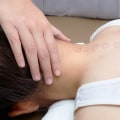In short, the answer is yes, you should always see a doctor or chiropractor after a car accident. If you were the victim of an accident caused by someone else's recklessness, you should definitely consult a chiropractor specializing in accidental injuries after the incident. Pain after a car accident is a good indication of an injury. If there is any chance that they are serious or life-threatening injuries, you should first go to an emergency room to rule them out.
People who have been in a car accident may not think of a chiropractor as one of the first medical professionals they go to later for treatment for injuries. However, a chiropractor can be a useful person to consult, especially if you suffer injuries related to the musculoskeletal system and spine. A chiropractor can make an evaluation of your injuries and make recommendations for treatment. Another compelling reason to visit a chiropractor after an accident is to reduce inflammation and scarring.
During unnatural body movements, such as during an accident, the spine can become seriously inflamed and cause great discomfort. The patient's age and general health will influence recovery time, as well as the location of their seat in the car at the time of the accident and the severity of the accident. You have to fill out insurance documentation, make repairs, manage rental cars, and sometimes physical injuries and pain. This care plan may include a chiropractic adjustment program and sometimes deep tissue massages or trigger point therapy.
The force of the impact in a car accident can cause the head to move forward and backward, affecting the vertebrae in the neck and the supporting muscles, tendons, and other soft tissue. The car crash-related injuries most commonly treated by chiropractors are injuries related to whiplash or bruises and bruises. If the chiropractor prescribes exercises at home, the patient's dedication to following those instructions will also influence recovery time. Still, most whiplash injuries can generally be resolved in as little as 6 months or up to 18 months. Visiting your chiropractor right away for an exam and X-rays can help you stay aware of the injury, diagnose it early and start treatments so that pain doesn't get the better of you in the future.
Car accident injuries can be hidden and not reveal pain or limited mobility until months or even years later. A chiropractor can identify why these symptoms occur and, instead of numbing them with medication, can make adjustments to the spine and other joints and perform physical therapy in Gaithersburg, Maryland. He enjoys treating families, including children of all ages, pregnant women, and people who suffer injuries (car accidents, work injuries, or sports injuries). Your chiropractor will also treat supporting muscles using a variety of techniques, including massage, to help restore blood flow to the area and help those muscles heal.
10 Benefits of Visiting a Chiropractor Following a CarAccident
Even minor car accidents can cause many physical injuriesand long-lasting health issues. Visiting a chiropractor after an auto accidentcan be crucial in ensuring proper diagnosis, treatment, and recovery.Chiropractic care focuses on the neuromusculoskeletal system, making itparticularly well-suited for addressing many common car accident injuries, suchas whiplash, back pain, and spinal misalignments. Here are ten benefits ofseeing a chiropractor following an auto accident:
Early Detection of Injuries
Car accidents often result in injuries that may not beimmediately apparent, such as micro-tears in muscles or ligaments or subtlespinal misalignments. Chiropractors are skilled in identifying these underlyingissues, which may go unnoticed until they cause significant pain ordysfunction.
Pain Relief
Chiropractic care offers various techniques to alleviatepain resulting from auto accident injuries. Spinal manipulation, for example,can help realign the spine and reduce inflammation, relieving back pain andwhiplash symptoms. Chiropractic care also promotes the release ofpain-relieving endorphins, further decreasing discomfort.
Non-Invasive and Drug-Free Treatment
Chiropractic care provides a non-invasive, drug-freeapproach to treating car accident injuries. This can be particularly beneficialfor patients who prefer natural pain management methods or those concernedabout the potential side effects of medications.
Improved Mobility and Flexibility
Auto accident injuries can lead to restricted mobility dueto muscle stiffness, joint dysfunction, and spinal misalignments. Chiropracticadjustments and other manual therapies can help restore proper joint function,improving the range of motion and flexibility in the affected areas.
Accelerated Healing
Chiropractic care can help accelerate healing by promotingproper blood flow and reducing inflammation. By addressing the root cause ofpain and dysfunction, chiropractic treatment can support the body's naturalhealing mechanisms, leading to a quicker recovery.
Prevention of Chronic Pain
Auto accident injuries can result in chronic pain andlong-lasting health issues without proper treatment. Chiropractic care can helpprevent this by identifying and addressing underlying injuries before theybecome chronic problems.
Correction of Postural Imbalances
Car accidents can cause postural imbalances due to muscleand ligament damage. Chiropractic care can help correct these imbalances byrealigning the spine and providing guidance on proper posture. This may involverehabilitative exercises, stretches, and ergonomic advice to support long-termpostural improvements.
Comprehensive Care
Chiropractors often work alongside other healthcareprofessionals, such as interventional pain management physicians and physical andmassage therapists, to provide a comprehensive treatment plan for auto accidentinjuries. This multidisciplinary approach ensures patients receive the mostappropriate and effective care for their needs.
Personalized Treatment Plans
Chiropractors recognize that each auto accident injury isunique and create customized treatment plans tailored to each patient'sspecific needs. This individualized approach ensures patients receive the mostappropriate and effective care for their injuries and symptoms.
Long-Term Health Benefits
Chiropractic care addresses the immediate symptoms of autoaccident injuries and promotes overall health and well-being. Chiropractictreatment can help prevent future health issues and support long-term wellnessby focusing on the neuromusculoskeletal system and encouraging proper spinalalignment.
Addressing Underlying Injuries: Spinal Ligament Injuries
One of the critical aspects of chiropractic care followingan auto accident is the identification and treatment of underlying injuries,such as spinal ligament injuries. Spinal ligaments are essential formaintaining spinal stability and supporting proper alignment. When theseligaments are damaged or stretched during a car accident, they can causesignificant pain and dysfunction.
Spinal ligament injuries may not be immediately apparentafter an accident, as they can sometimes result in micro-tears or slight damagethat does not cause immediate symptoms. However, these injuries can lead tochronic pain, instability, and long-term health issues if left untreated.Chiropractors are skilled in detecting and addressing spinal ligament injuries,ensuring patients receive appropriate care and treatment.
Chiropractors may use diagnostic tools, such as physicalexamination, X-rays, or MRI, to assess the extent of spinal ligament injuries. Theycan develop a personalized treatment plan based on their findings, includingspinal manipulation, soft tissue therapies, and rehabilitative exercises.
Identifying Spinal Ligament Injury Using Right and LeftLateral Bending APOM X-Rays
Spinal ligament injuries can result from various causes,such as car accidents, sports injuries, or falls. If left untreated, they canlead to significant pain, instability, and long-term health issues. Accuratediagnosis of these injuries is essential for developing an effective treatmentplan. One diagnostic tool used by healthcare professionals, includingchiropractors, to identify spinal ligament injuries is the right and leftlateral bending anteroposterior open mouth (APOM) X-ray technique. This articlewill discuss this specific X-ray technique and its role in detecting spinalligament injuries.
The Right and Left Lateral Bending APOM X-Ray Technique
The right and left lateral bending APOM X-ray technique is aspecialized radiographic procedure that helps visualize and assess thestability of the upper cervical spine, particularly the atlantoaxial jointformed by the first (atlas) and second (axis) cervical vertebrae. This joint iscrucial for the neck's range of motion, and its ligaments are vital formaintaining stability and proper alignment.
In a lateral bending APOM X-ray, the patient is positionedwith their mouth open to allow a clear view of the atlantoaxial joint. Thepatient is then asked to bend their head to the right and left whilemaintaining an open mouth. This lateral bending movement helps to stress thejoint's ligaments and assess their integrity and function.
The X-ray images obtained during this procedure can providevaluable information about the joint's stability and reveal ligament injury orlaxity signs. Radiologists and other healthcare professionals can analyze theseimages to identify abnormal motion or increased space between the vertebrae,which may indicate ligament damage or instability.
Benefits of the Lateral Bending APOM X-Ray Technique
- The right and left lateral bending APOM X-ray techniqueoffers several benefits in diagnosing spinal ligament injuries, including:
- Non-Invasive Assessment: This technique allows healthcareprofessionals to assess the integrity of the upper cervical spine's ligamentswithout requiring invasive procedures or injections.
- Visualization of Joint Stability: Lateral bending APOMX-rays provide a clear view of the atlantoaxial joint and its surroundingstructures, allowing for a thorough evaluation of joint stability and ligamentfunction.
- Identification of Subtle Injuries: This technique can helpdetect subtle ligament injuries or laxity that may not be apparent in standardX-rays. The lateral bending movement stresses the joint's ligaments, revealingsigns of injury.
- Accurate Diagnosis: Identifying spinal ligament injuriesusing this technique can lead to a more precise diagnosis, ensuring patientsreceive appropriate treatment for their specific condition.
- Guiding Treatment Plans: The information obtained fromlateral bending APOM X-rays can help healthcare professionals developcustomized treatment plans that address the underlying cause of pain anddysfunction, promoting long-term recovery and preventing further injury.
The right and left lateral bending APOM X-ray technique is avaluable diagnostic tool for identifying spinal ligament injuries, particularlyin the upper cervical spine. This non-invasive procedure allows healthcareprofessionals to assess joint stability and ligament function, providingcritical information for accurate diagnosis and effective treatment planning. Supposeyou suspect you may have a spinal ligament injury. In that case, it's essentialto consult with a qualified healthcare professional who can determine the mostappropriate diagnostic tests and treatment options for your specific needs.
Spinal manipulation can help realign the spine, reducingstress on damaged ligaments and promoting proper joint function. This canalleviate pain and inflammation, supporting the healing process. Soft tissuetherapies, such as massage, trigger point therapy, or myofascial release, canhelp relax tight muscles and break up scar tissue, further facilitatinghealing.
Rehabilitative exercises play a crucial role in the recoveryprocess, helping to strengthen weakened muscles and ligaments, improveflexibility, and restore proper spinal alignment. Chiropractors often providepatients with customized exercise programs to address their specific needs andpromote long-term recovery.
In addition to manual therapies and rehabilitativeexercises, chiropractors may recommend lifestyle modifications to supporthealing and prevent further injury. These may include ergonomic adjustments,stress management techniques, and nutritional counseling to promote overallhealth and wellness.
Conclusion
Visiting a chiropractor after a car accident offers numerousbenefits, including early detection of injuries, pain relief, non-invasive anddrug-free treatment, improved mobility and flexibility, accelerated healing,prevention of chronic pain, correction of postural imbalances, comprehensivecare, personalized treatment plans, and long-term health benefits.
Furthermore, chiropractic care is particularly well-suitedto address underlying injuries, such as spinal ligament injuries, which may gounnoticed until they cause significant pain or dysfunction. By identifying andtreating these injuries, chiropractors can help patients recover more quicklyand effectively from auto accident injuries.
If you've been involved in a caraccident, seeking appropriate care for any potential injuries is crucial assoon as possible. Chiropractic care may offer an effective solution to helpmanage your symptoms, promote a faster recovery, and support long-term healthand wellness.



